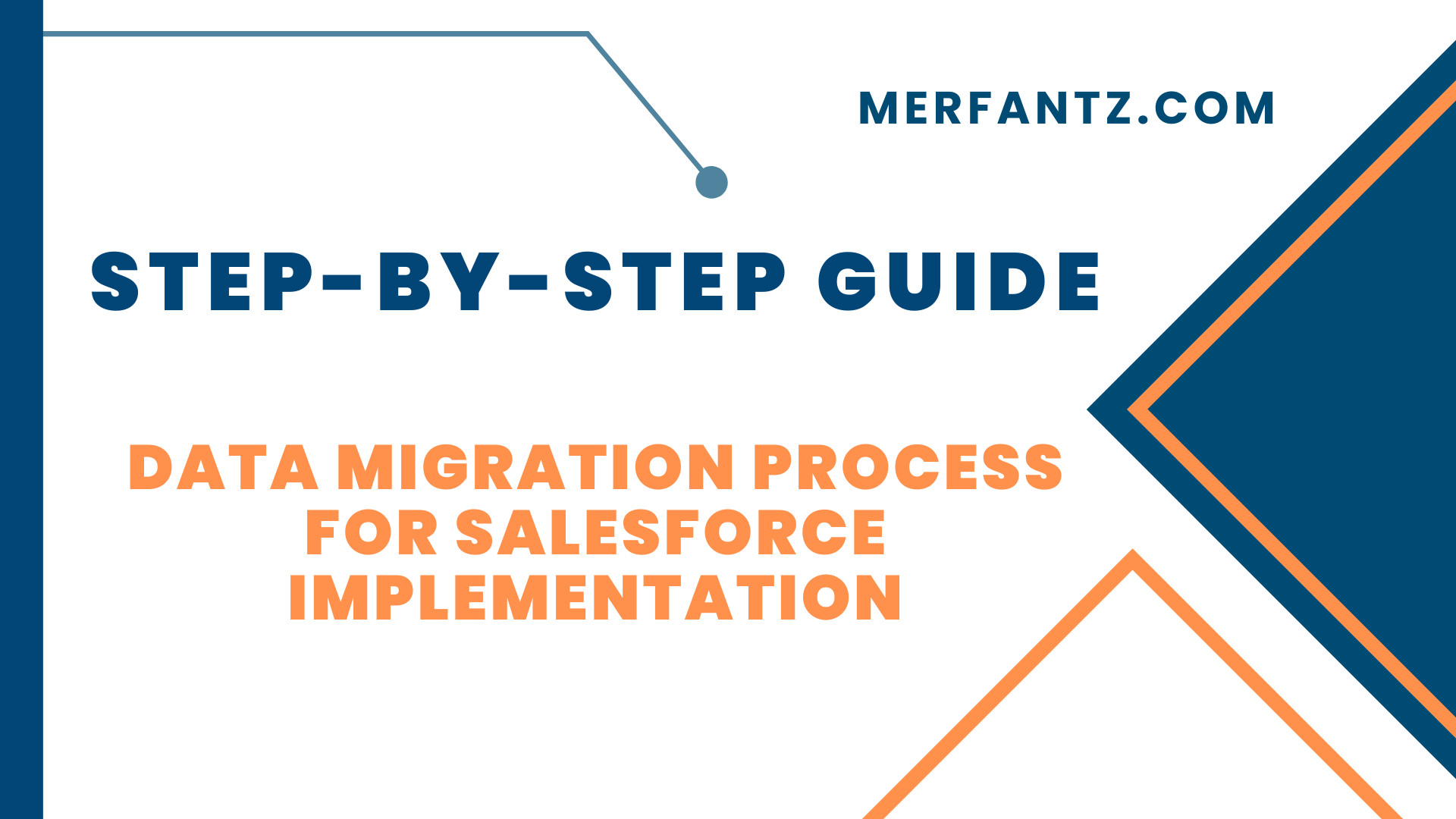Understanding the Importance of Data Migration in Salesforce Implementation
Data migration plays a crucial role in the successful implementation of Salesforce, the leading customer relationship management (CRM) platform. It involves the transfer of data from existing systems to Salesforce, ensuring a seamless transition and continuity of essential business information. Data migration is vital because it enables organizations to harness the full power of Salesforce by bringing in historical data, customer records, sales data, and other valuable information into a centralized and easily accessible platform. By migrating data accurately, businesses can leverage Salesforce’s robust features, gain actionable insights, enhance customer interactions, and make informed business decisions.
During a Salesforce implementation, understanding the importance of data migration is essential for planning and executing a successful transition. It involves evaluating the quality, integrity, and relevance of existing data, identifying any gaps or inconsistencies, and defining strategies to address them. Data migration allows organizations to maintain data continuity, historical records, and seamless operations while adopting a new CRM system. With the right data migration approach, businesses can optimize Salesforce’s capabilities and maximize the benefits of the CRM platform, driving growth, efficiency, and improved customer experiences.
Assessing Data Readiness: Preparing Your Existing Data for Migration
Before embarking on the data migration process, it is crucial to assess the readiness of your existing data. This involves a comprehensive evaluation of data quality, structure, and relevance. Start by identifying the types of data you need to migrate, such as customer information, sales records, or product data. Then, conduct a thorough data cleansing process to eliminate duplicate, outdated, or irrelevant records. By ensuring data cleanliness, you can prevent any issues or discrepancies during the migration process, resulting in accurate and reliable data in your Salesforce instance.
Furthermore, assess the compatibility of your existing data with Salesforce’s data model. Understand the data structure and fields within Salesforce, and map them to the corresponding fields in your current system. This step is critical to ensure seamless data migration without losing any important information. By assessing data readiness and performing the necessary preparations, you can streamline the migration process and minimize potential data errors, setting the foundation for a successful Salesforce implementation.
Creating a Data Migration Strategy for Salesforce Implementation
Creating a data migration strategy is a crucial step in a successful Salesforce implementation. Start by defining your migration goals and objectives. Determine what data you want to migrate, the order of priority, and any specific requirements or considerations. Consider the data migration timeline, resource allocation, and potential challenges that may arise during the process. By developing a clear and comprehensive strategy, you can ensure a structured approach to data migration, minimizing disruptions and maximizing efficiency.
Next, establish a data migration plan that outlines the step-by-step process for migrating your data to Salesforce. This plan should include tasks such as data extraction, transformation, mapping, validation, and migration. Assign responsibilities to team members involved in the migration process and set realistic timelines for each task. By creating a well-defined data migration strategy, you can ensure that the process is executed smoothly, minimizing risks and optimizing the utilization of Salesforce for your organization.
Selecting the Right Data Migration Tools and Technologies
Selecting the appropriate data migration tools and technologies is essential for a seamless Salesforce implementation. Start by evaluating the available options and consider factors such as compatibility, scalability, and ease of use. Look for tools that offer features like data mapping, data cleansing, and data validation to ensure data accuracy and integrity during the migration process. Additionally, consider integration capabilities with your existing systems and the level of support provided by the tool’s vendor. Choosing the right tools will streamline the data migration process and enhance the overall implementation experience.
Furthermore, ensure that the selected data migration tools align with your organization’s security and compliance requirements. Data privacy and protection are paramount, so choose tools that prioritize data security measures such as encryption and access controls. Conduct thorough research, read user reviews, and consult with experts to make an informed decision. By selecting the right data migration tools and technologies, you can facilitate a smooth and secure transfer of data to Salesforce, ensuring the integrity and confidentiality of your business information.
Extracting and Transforming Data: Best Practices for Data Cleansing and Formatting
Data cleansing and formatting are critical steps in the data migration process for Salesforce implementation. Begin by extracting data from your existing systems, ensuring that the data is complete and accurate. Cleanse the data by removing any duplicate, incomplete, or inconsistent records. Perform data validation checks to identify and resolve any data quality issues. Additionally, format the data according to Salesforce’s data model, ensuring that it aligns with the required data structure, field types, and naming conventions. By following best practices for data cleansing and formatting, you can ensure high-quality data in your Salesforce instance.
Consider implementing data transformation processes to harmonize and standardize your data. This may involve converting data formats, normalizing data values, or mapping data from different systems into a unified structure. Apply data enrichment techniques to enhance the quality and completeness of your data. These practices ensure that your data is in a consistent and usable state, enabling better data analysis and decision-making within Salesforce. By adhering to best practices for data cleansing and formatting, you can optimize the value of your migrated data and improve the overall effectiveness of your Salesforce implementation.
Mapping Data Fields: Ensuring Accuracy and Integrity During Migration
Accurate mapping of data fields is crucial to maintain data integrity during the migration process. Start by analyzing the data structure and field mappings between your existing system and Salesforce. Identify any discrepancies or differences in field names, types, or formats. Create a comprehensive mapping plan that specifies how each field in your existing system should be mapped to its corresponding field in Salesforce. Take into account any data transformations or conversions required during the mapping process. Thoroughly test and validate the data mappings to ensure accuracy and consistency in your Salesforce instance.
During the mapping process, pay attention to complex data relationships and dependencies. Consider how related data, such as accounts, contacts, and opportunities, should be mapped to maintain the integrity of the relationships within Salesforce. Use data mapping tools or features provided by your chosen migration tool to simplify the process and minimize the potential for errors. By meticulously mapping data fields, you can ensure that the right information is transferred to the correct fields in Salesforce, preserving the integrity and accuracy of your data throughout the migration.
Testing and Validating Data Migration: Verifying Data Integrity
Testing and validating the data migration process is crucial to ensure data integrity and accuracy in your Salesforce implementation. Develop a comprehensive testing plan that includes sample data sets representative of your actual data. Execute test migrations to verify that the data is transferred correctly and that the mapping, transformations, and formatting are accurately applied. Validate the migrated data by comparing it with the original data in your existing system. Perform data validation checks to identify any discrepancies or errors. Thorough testing and validation ensure a smooth transition and minimize any potential data issues during the Salesforce implementation.
Consider involving key stakeholders and subject matter experts in the testing and validation process. Their insights and expertise can help identify any gaps or issues in the migrated data. Document and track any identified issues and discrepancies and prioritize their resolution. Conduct multiple iterations of testing and validation to ensure that the data migration process is refined and any issues are resolved. By thoroughly testing and validating the data migration, you can instill confidence in the accuracy and integrity of the migrated data, setting a strong foundation for your Salesforce implementation.
Executing the Data Migration Process: Step-by-Step Implementation Guide
Executing the data migration process requires a step-by-step implementation guide to ensure a smooth and successful transition to Salesforce. Start by defining a migration timeline and allocating resources accordingly. Execute the migration in stages or phases, focusing on specific data sets or modules at a time. Follow the established data migration strategy and utilize the selected tools and technologies to transfer the data. Monitor the migration process closely, addressing any issues or errors that may arise promptly. By following a structured implementation guide, you can minimize disruptions, maintain data integrity, and achieve a successful Salesforce implementation.
Communicate with your team and stakeholders throughout the data migration process. Keep them informed about the progress, any challenges encountered, and the expected timeline for completion. Provide necessary training and support to users who will interact with the migrated data in Salesforce. Conduct post-migration validation to ensure that the data has been accurately migrated and is readily accessible. By executing the data migration process with a well-defined guide, effective communication, and comprehensive validation, you can achieve a smooth transition to Salesforce and empower your organization with reliable and actionable data.
Post-Migration Data Validation and Quality Assurance
Post-migration data validation and quality assurance are essential steps to ensure the accuracy and completeness of your migrated data in Salesforce. Conduct thorough data validation checks to compare the migrated data with the original source data. Verify that all data fields, relationships, and dependencies have been accurately transferred. Perform data integrity checks to identify any anomalies or discrepancies that may have occurred during the migration process. Address any issues promptly and make the necessary adjustments to ensure the reliability of your data within Salesforce.
Implement a comprehensive data quality assurance process to maintain the integrity of your data in Salesforce. Regularly monitor and clean your data to remove duplicates, inconsistencies, or outdated records. Establish data governance policies and practices to ensure ongoing data quality. Continuously validate and update your data to ensure it remains accurate, relevant, and useful for your organization. By prioritizing post-migration data validation and quality assurance, you can maintain the reliability and usability of your data in Salesforce, supporting effective decision-making and efficient operations.
Data Migration Best Practices: Tips for a Smooth and Successful Salesforce Implementation
Implementing data migration best practices is crucial for a smooth and successful Salesforce implementation. Start by thoroughly understanding your data and its unique characteristics. Analyze the data structure, relationships, and dependencies to ensure accurate mapping and successful migration. Invest time and effort in data cleansing, formatting, and transformation to ensure data integrity and consistency. Select the right data migration tools and technologies that align with your requirements and prioritize data security. By following these best practices, you can minimize risks, optimize data quality, and enhance the overall success of your Salesforce implementation.
Additionally, establish a robust testing and validation process to identify and address any issues during the data migration. Test the migration process with representative sample data and validate the migrated data against the original source. Involve stakeholders and subject matter experts in the testing and validation process to gain valuable insights and ensure comprehensive data verification. Develop a detailed data migration strategy and execution plan, clearly defining roles, responsibilities, and timelines. Regularly communicate with your team and stakeholders, providing necessary training and support throughout the implementation. By adhering to data migration best practices, you can achieve a smooth and successful Salesforce implementation, empowering your organization with a powerful CRM platform.
FAQ (Frequently Asked Questions):
What is data migration in Salesforce implementation?
Data migration in Salesforce implementation refers to the process of transferring data from existing systems to Salesforce, ensuring a seamless transition and continuity of essential business information. It involves extracting, cleansing, transforming, and mapping data to align with Salesforce’s data structure. Data migration enables organizations to leverage Salesforce’s robust features, gain insights, and make informed decisions based on accurate and consolidated data.
Why is data migration important in Salesforce implementation?
Data migration is important in Salesforce implementation because it allows organizations to bring in historical data, customer records, sales data, and other valuable information into a centralized and easily accessible platform. By migrating data accurately, businesses can harness the full power of Salesforce, optimize its capabilities, and drive growth, efficiency, and improved customer experiences. Data migration ensures continuity, data integrity, and the ability to leverage Salesforce’s features effectively.
What are the challenges in data migration for Salesforce implementation?
Data migration for Salesforce implementation can present several challenges. Some common challenges include ensuring data accuracy and integrity, handling complex data relationships, mapping data fields accurately, dealing with data inconsistencies or duplicates, and managing the volume and complexity of data. It is crucial to have a well-defined strategy, the right tools and technologies, and a thorough testing and validation process to address these challenges and ensure a successful data migration.
How can I ensure data quality during the data migration process?
Ensuring data quality during the data migration process involves several best practices. It includes performing data cleansing to eliminate duplicates, inconsistencies, and irrelevant records. Data formatting and transformation should be applied to ensure data consistency and conformity with Salesforce’s data model. Thorough testing and validation should be conducted to compare the migrated data with the original source data and address any discrepancies. Implementing ongoing data quality assurance practices, such as regular monitoring and cleaning of data, is also essential to maintain data quality in Salesforce.
What are the steps of a data migration project?
The steps of a data migration project typically include:
- Planning and scoping the project
- Analyzing and profiling the data
- Extracting and cleansing the data
- Mapping and transforming the data
- Testing and validating the migration
- Executing the migration
- Verifying the migrated data
- Post-migration validation and quality assurance.
How does data migration work in Salesforce?
Data migration in Salesforce involves extracting data from the source system, cleansing and formatting it, mapping the fields to Salesforce’s data model, and transforming the data as needed. The data is then loaded into Salesforce using data migration tools or APIs. Thorough testing and validation are performed to ensure data accuracy and integrity throughout the migration process.
How do you implement data migration?
Implementing data migration involves following a structured approach, including:
- Defining migration goals and objectives
- Assessing data readiness and quality
- Creating a migration strategy and plan
- Selecting the appropriate migration tools and technologies
- Extracting, cleansing, and transforming the data
- Mapping the data fields accurately
- Testing and validating the migration process
- Executing the migration with proper monitoring and support.
What are the 6 types of data migration?
The six types of data migration are:
- Storage migration: Moving data from one storage system to another.
- Database migration: Transferring data between different database systems.
- Application migration: Moving data from one application to another.
- Business process migration: Migrating data associated with specific business processes.
- Cloud migration: Transferring data from on-premises systems to cloud platforms.
- Platform migration: Shifting data from one technology platform to another.
Conclusion:
In conclusion, the step-by-step data migration process is a critical component of a successful Salesforce implementation. By understanding the importance of data migration, assessing data readiness, and creating a comprehensive strategy, organizations can ensure a seamless transition to Salesforce. Selecting the right data migration tools, extracting and transforming data, mapping data fields accurately, and testing and validating the migration process are essential steps to maintain data integrity. By executing the migration process with precision, organizations can achieve a smooth transition, validate the migrated data, and ensure ongoing data quality and reliability within Salesforce. By following data migration best practices, organizations can leverage the full potential of Salesforce, enhance customer interactions, and make data-driven decisions that drive business growth and success.
Author Bio
Co-Founder & CMO at Merfantz Technologies Pvt Ltd | Marketing Manager for FieldAx Field Service Software | Salesforce All-Star Ranger and Community Contributor | Salesforce Content Creation for Knowledge Sharing






